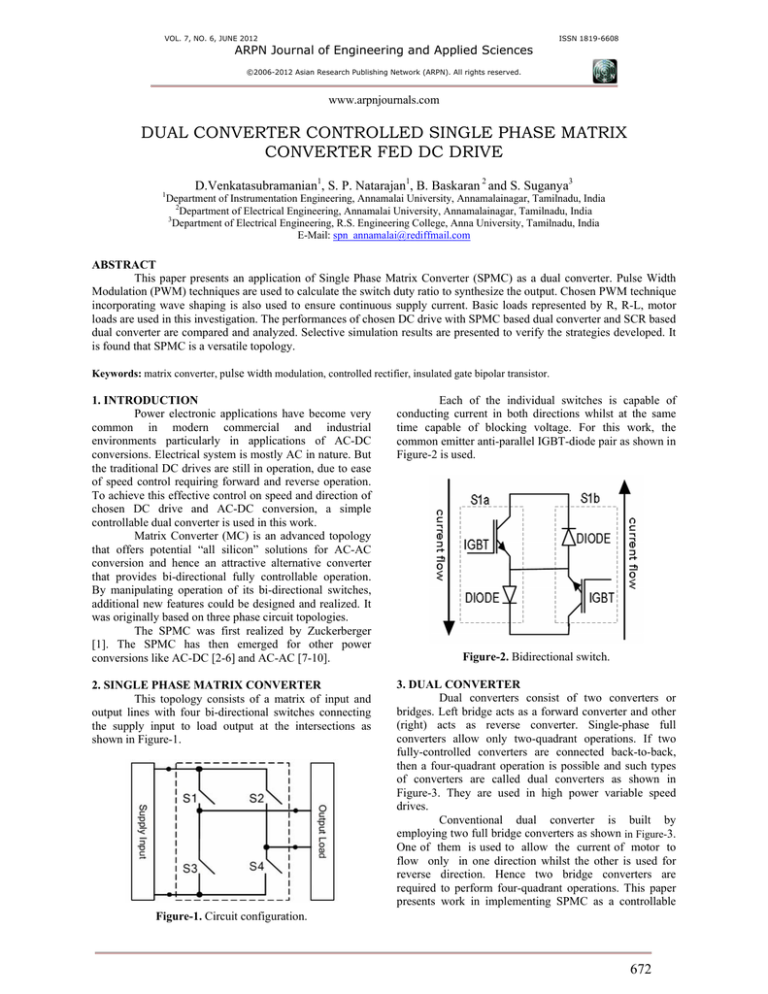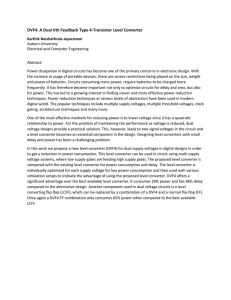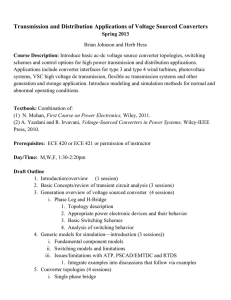
VOL. 7, NO. 6, JUNE 2012
ISSN 1819-6608
ARPN Journal of Engineering and Applied Sciences
©2006-2012 Asian Research Publishing Network (ARPN). All rights reserved.
www.arpnjournals.com
DUAL CONVERTER CONTROLLED SINGLE PHASE MATRIX
CONVERTER FED DC DRIVE
D.Venkatasubramanian1, S. P. Natarajan1, B. Baskaran 2 and S. Suganya3
1
Department of Instrumentation Engineering, Annamalai University, Annamalainagar, Tamilnadu, India
2
Department of Electrical Engineering, Annamalai University, Annamalainagar, Tamilnadu, India
3
Department of Electrical Engineering, R.S. Engineering College, Anna University, Tamilnadu, India
E-Mail: spn_annamalai@rediffmail.com
ABSTRACT
This paper presents an application of Single Phase Matrix Converter (SPMC) as a dual converter. Pulse Width
Modulation (PWM) techniques are used to calculate the switch duty ratio to synthesize the output. Chosen PWM technique
incorporating wave shaping is also used to ensure continuous supply current. Basic loads represented by R, R-L, motor
loads are used in this investigation. The performances of chosen DC drive with SPMC based dual converter and SCR based
dual converter are compared and analyzed. Selective simulation results are presented to verify the strategies developed. It
is found that SPMC is a versatile topology.
Keywords: matrix converter, pulse width modulation, controlled rectifier, insulated gate bipolar transistor.
1. INTRODUCTION
Power electronic applications have become very
common in modern commercial and industrial
environments particularly in applications of AC-DC
conversions. Electrical system is mostly AC in nature. But
the traditional DC drives are still in operation, due to ease
of speed control requiring forward and reverse operation.
To achieve this effective control on speed and direction of
chosen DC drive and AC-DC conversion, a simple
controllable dual converter is used in this work.
Matrix Converter (MC) is an advanced topology
that offers potential “all silicon” solutions for AC-AC
conversion and hence an attractive alternative converter
that provides bi-directional fully controllable operation.
By manipulating operation of its bi-directional switches,
additional new features could be designed and realized. It
was originally based on three phase circuit topologies.
The SPMC was first realized by Zuckerberger
[1]. The SPMC has then emerged for other power
conversions like AC-DC [2-6] and AC-AC [7-10].
Each of the individual switches is capable of
conducting current in both directions whilst at the same
time capable of blocking voltage. For this work, the
common emitter anti-parallel IGBT-diode pair as shown in
Figure-2 is used.
2. SINGLE PHASE MATRIX CONVERTER
This topology consists of a matrix of input and
output lines with four bi-directional switches connecting
the supply input to load output at the intersections as
shown in Figure-1.
3. DUAL CONVERTER
Dual converters consist of two converters or
bridges. Left bridge acts as a forward converter and other
(right) acts as reverse converter. Single-phase full
converters allow only two-quadrant operations. If two
fully-controlled converters are connected back-to-back,
then a four-quadrant operation is possible and such types
of converters are called dual converters as shown in
Figure-3. They are used in high power variable speed
drives.
Conventional dual converter is built by
employing two full bridge converters as shown in Figure-3.
One of them is used to allow the current of motor to
flow only in one direction whilst the other is used for
reverse direction. Hence two bridge converters are
required to perform four-quadrant operations. This paper
presents work in implementing SPMC as a controllable
Figure-2. Bidirectional switch.
Figure-1. Circuit configuration.
672
VOL. 7, NO. 6, JUNE 2012
ISSN 1819-6608
ARPN Journal of Engineering and Applied Sciences
©2006-2012 Asian Research Publishing Network (ARPN). All rights reserved.
www.arpnjournals.com
dual converter by suitable switching schemes for
bi-directional speed control of DC motor.
Figure-5. State-1: AC input positive cycle
and positive load voltage.
Figure-3. Typical dual converter.
4. SPMC AS A DUAL CONVERTER
In this paper the proposed dual converter as
shown in Figure-4 is developed using SPMC.
The operating mode of the proposed dual
converter is divided into two main operations-forward
mode and reverse mode. Table-1 and Table-2 show the
switching sequence for SPMC based dual converter.
Figure-6. State-2: AC input positive cycle
and negative load voltage.
Figure-7. State-3: AC input negative cycle
and positive load voltage.
Figure-4. Dual converter using SPMC.
In the proposed method, during the positive cycle
of AC input, current flows through the appropriate pair of
switches S1a and S4a as indicated in Figure-5 producing
positive load voltage for forward direction.
For producing the negative load voltage current
flows through the switches S2b and S3b as indicated in
Figure-6 (state 2). Similarly positive and negative load
voltage can be obtained for AC input negative cycle as
indicated in Figures 7 and 8.
Figure-8. State-4: AC input negative cycle
and negative load voltage.
673
VOL. 7, NO. 6, JUNE 2012
ISSN 1819-6608
ARPN Journal of Engineering and Applied Sciences
©2006-2012 Asian Research Publishing Network (ARPN). All rights reserved.
www.arpnjournals.com
The frequency of reference signal sets the output
frequency fo. The carrier frequency fc determines the
number of pulses per half cycle. By varying the
modulation index (ma), the output voltage could be
controlled.
The switching sequence suggested in Table-2
gives the operation of the SPMC based dual converter
either in forward motoring or reverse motoring mode
pertaining to I and II quadrant of operation. The switching
pattern of the four switches can be obtained using the four
possible states as shown in Figures 5 to 8.
5. PULSE WIDTH MODULATION
PWM is a widely used technique for controlling
the output of static power converters. PWM is immune to
noise and less susceptible to voltage changes.
The harmonic content can be reduced by using
PWM pulses in each half cycle of output voltage. The
SPMC needs four gating signals for four bi-directional
switches. By comparing an adjustable reference signal
with a triangular carrier signal, the PWM pulses are
generated for turning ON and OFF of power switches in
SPMC as illustratred in Figure-9.
Table-1. Switching sequence for SPMC.
Switch
State
1
S1a
S1b
S2a
S2b
S3a
S3b
S4a
S4b
ON
OFF
OFF
OFF
OFF
OFF
ON
OFF
2
OFF
OFF
OFF
ON
OFF
ON
OFF
OFF
3
OFF
OFF
ON
OFF
ON
OFF
OFF
OFF
4
OFF
ON
OFF
OFF
OFF
OFF
OFF
ON
Table-2. Sequence of switching control for SPMC based
bi-directional DC drive.
Switch “ON”
S1a and S4a
S2a and S3a
S1b and S4b
S2b and S3b
Motor rotation
State used
Forward
1 and 3
Reverse
2 and 4
Figure-10. PWM pulse generation using PSB.
The circuit as shown in Figure-10 (simulation in
MLS) is implemented with PWM to generate switching
signals for controlling the power switches. The modulation
index ma is varied from 0.1 until 0.9 in steps of 0.1 in the
present work.
Figure-9. Formation of PWM pulses.
6. SIMULATION IMPLEMENTATION
The proposed control concept is verified through
simulation using MATLAB-SIMULINK as shown in
Figure-10. Power System Block Set (PSB) in MATLABSIMULINK (MLS) is used to model and simulate the
circuit.
7. RESULTS AND DISCUSSIONS
The dual converter using SPMC is energized by
230V AC supply and loaded with resistive, inductive and
motor load (R = 50 ohm L = 9mH and 5HP DC motor)
operated with different modulation indices ma 0.3, 0.5 and
0.7. The simulation model as shown in Figure-11 and the
subsystems as shown in Figures 12 (a) and (b) are used to
study the behavior of the SPMC as dual converter under
variety of load conditions as seen in results in Figures 13
to 19.
Figures 13 and 14 show sample results for ma =
0.5 obtained from simulation to illustrate the operation of
674
VOL. 7, NO. 6, JUNE 2012
ISSN 1819-6608
ARPN Journal of Engineering and Applied Sciences
©2006-2012 Asian Research Publishing Network (ARPN). All rights reserved.
www.arpnjournals.com
dual converter feeding R load. With pure resistive load no
spikes are apparent. Figures 15 and 16 display sample
results obtained from simulation to illustrate the operation
of dual converter feeding R-L load for same ma.
Noticeable spikes are produced due to
introduction of inductive load. Figures 17 and 18 show the
output voltage and current of SPMC based dual converter
feeding DC motor. Figure-19 shows the speed of the DC
motor in two quadrant mode.
DC motor specifications are:
Capacity = 5HP
Voltage = 230V
Current = 20A
Winding = Lap
No. of poles = four pole
PWM Pulses
s1a,s4a
s2b,s3b
s2a,s3a
s1b,s4b
s1a
s1b
P
s2a
s2b
s3a
AC Source
230V,50HZ
s3b
N
s4a
Torque
s4b
0.1
L+
DC_Motor
5 hp; 240V;
TL
A+
-Km
dc
Gain
A-
LF+
SPM
F-
v
Vout
OUTPUT
+
-
Vf
Figure-11. SPMC feeding DC motor load.
The simulation is also carried out with SCR
based dual converter and results are also presented for
purely resistive load, inductive load and motor load.
The output voltage and current obtained with
pure resistive load and inductive load for firing angle (fa)
300 are shown in Figures 20 to 23.
Figures 24 to 26 portray the armature voltage,
armature current and speed obtained through simulation
studies on implementation of SCR based dual converter
with DC motor load for firing angle of 600 and next Figure
shows the speed for fa = 300 .
Results for the SCR based dual converter are
compared with those of SPMC based dual converter.
Figures 28 to 30 show the variation of armature voltage,
speed and % THD for various modulation indices of
SPMC based dual converter.
Figure-31 shows the armature voltage for
different firing angles and it is found that the armature
voltage increases with decrease in firing angle of SCR
based dual converter.
Figure-32 shows the speed of the motor for
various firing angles and decrease in speed is noticed with
increase in firing angle. Figure-33 shows the variation in
% THD for different firing angles. The result shows that
harmonics distortion increases with increase in firing
angle.
On comparison of all results it is observed that
the variation of armature voltage with SPMC based dual
converter is smoother than that of SCR based dual
converter. It is found that the magnitude of THD is lesser
with SPMC based dual converter.
Figure-12(a). SPMC subsystem common emitter IGBT
with diode pair.
675
VOL. 7, NO. 6, JUNE 2012
ISSN 1819-6608
ARPN Journal of Engineering and Applied Sciences
©2006-2012 Asian Research Publishing Network (ARPN). All rights reserved.
www.arpnjournals.com
Figure-12 (b). SPMC subsystem with SCR pair.
Figure-16. Output current with ma = 0.5 (R-L load).
Figure-13. Output voltage with ma = 0.5 (R load).
Figure-17. Output voltage with ma = 0.5 (motor load).
Figure-14. Output current with ma = 0.5 (R load).
Figure-18. Output current with ma = 0.5 (motor load).
Figure-15. Output voltage with ma = 0.5 (R-L load).
Figure-19. Speed of DC motor for ma = 0.5.
676
VOL. 7, NO. 6, JUNE 2012
ISSN 1819-6608
ARPN Journal of Engineering and Applied Sciences
©2006-2012 Asian Research Publishing Network (ARPN). All rights reserved.
www.arpnjournals.com
Figure-20. Output voltage with fa = 30o (R load).
Figure-24. Output voltage with fa = 60o (motor load).
Figure-21. Output current with fa = 30o(R load).
Figure-25. Output current with fa = 60o (motor load).
Figure-22. Output voltage with fa = 30o (R-L load).
Figure-26. Speed of DC motor for fa = 600.
Figure-23. Output current with fa = 30o (R-L load).
Figure-27. Speed of DC motor for fa = 300.
677
VOL. 7, NO. 6, JUNE 2012
ISSN 1819-6608
ARPN Journal of Engineering and Applied Sciences
©2006-2012 Asian Research Publishing Network (ARPN). All rights reserved.
www.arpnjournals.com
Voltage (volts)
250
250
200
200
150
150
100
100
50
50
0
0
150
0.1 0.2 0.3 0.4 0.5 0.6 0.7 0.8 0.9
Figure-28. Output voltage versus modulation index.
120
90
60
30
Figure-31. Output voltage versus firing angle (degrees).
Speed (RPM)
1800
1600
1400
2000
1200
1500
1000
800
1000
600
500
400
0
200
150
120
90
60
30
0
0.1 0.2 0.3 0.4 0.5 0.6 0.7 0.8 0.9
Figure-29. Speed (rpm) versus modulation index.
Figure-32. Speed (rpm) versus firing angle (degrees).
THD(%)
140
120
300
250
200
150
100
50
0
100
80
60
40
20
0
0.1 0.2 0.3 0.4 0.5 0.6 0.7 0.8 0.9
Figure-30. % THD versus modulation index.
150
120
90
60
30
Figure-33. % THD versus firing angle (degrees).
678
VOL. 7, NO. 6, JUNE 2012
ISSN 1819-6608
ARPN Journal of Engineering and Applied Sciences
©2006-2012 Asian Research Publishing Network (ARPN). All rights reserved.
www.arpnjournals.com
8. CONCLUSIONS
Successful investigations on the operation of
SPMC based dual converter feeding DC drive in two
quadrant mode are presented. The gate pulse switching
patterns are generated by MLS. The use of SPMC in the
design of dual converter that has full controllability in both
forward and reverses directions has been analyzed. The
performances of DC drive with SPMC based rectifier and
SCR based rectifier are compared. It is found that SPMC
is a versatile topology.
[9] Muhammad H. Rashid. Power electronics circuits,
devices and applications.
[10] S. H. Hosseini and E. Babaei. 2001. A new
generalized direct matrix converter. In: IEEE
International Symposium on Industrial Electronics.
ISIE 2001.2: 1071-1076.
REFERENCES
[1] A. Zuckerberger, D. Weinstock and A. Alexandrovitz.
1997. Single-phase matrix converter. IEE Proc.
Electric power app. 144(4): 235-240.
[2] R. Baharom, H. Hashim, M.N. Seroji and M.K.
Hamzah. 2006. A new single phase dual converter
using single phase matrix converter. In: IEEE
International Power and Energy Conference.
[3] Bhim Singh, Brij N. Singh, Ambrish Chandra, Kamal
Al-Haddad, Ashish Pandey and Dwarka P. Kothari.
2003. A review of single-phase improved power
quality AC-DC converters. IEEE Transactions on
Industrial Electronics. 50(5).
[4] R. Baharom, A.S.A. Hasim, M.K. Hamzah and M.F.
Omar. 2006. A new single-phase controlled rectifier
using single-phase matrix converter. In: IEEE
International Power and Energy Conference, PEC on
'06. pp. 453-458.
[5] Rahimi Baharom and Mustafar Kamal. 2007. A new
single phase controlled rectifier using single-phase
matrix converter topology incorporating active power
filter. In: IEEE International Electric Machines and
Drives Conference, IEMDC '07. pp. 874-879.
[6] R. Baharom, M.K. Hamzah and A. Saparon I. R.
Ibrahim. 2008. Studies on control electronics
implementation of single-phase matrix converter
operating as AC DC converter with active power
filter. In: 2nd IEEE International Conference on Power
and Energy (PECon 08). Johor Baharu, Malaysia.
[7] A.M. Al-Kandari and T.H. Abdelhamid. 2002. A
sinusoidal PWM control for four-quadrant singlephase drive system. In: IEEE MELECON 2002.
Cairo, Egypt.
[8] P.W. Wheeler, J. Rodriguez, J.C. Clare, I.
Empringham and A. Weinstein. 2002. Matrix
converters- A technology review. IEEE Transactions
on Industrial Electronics. 49(2): 276-288.
679




